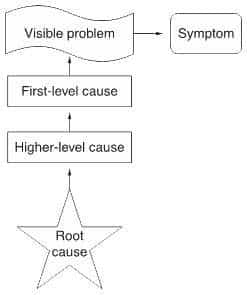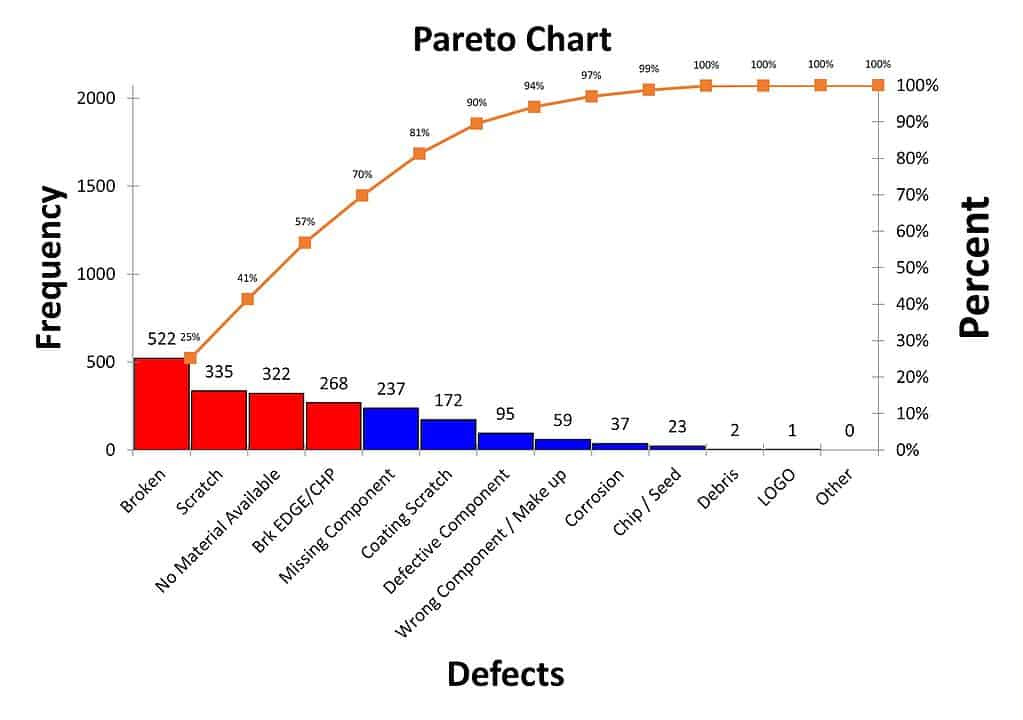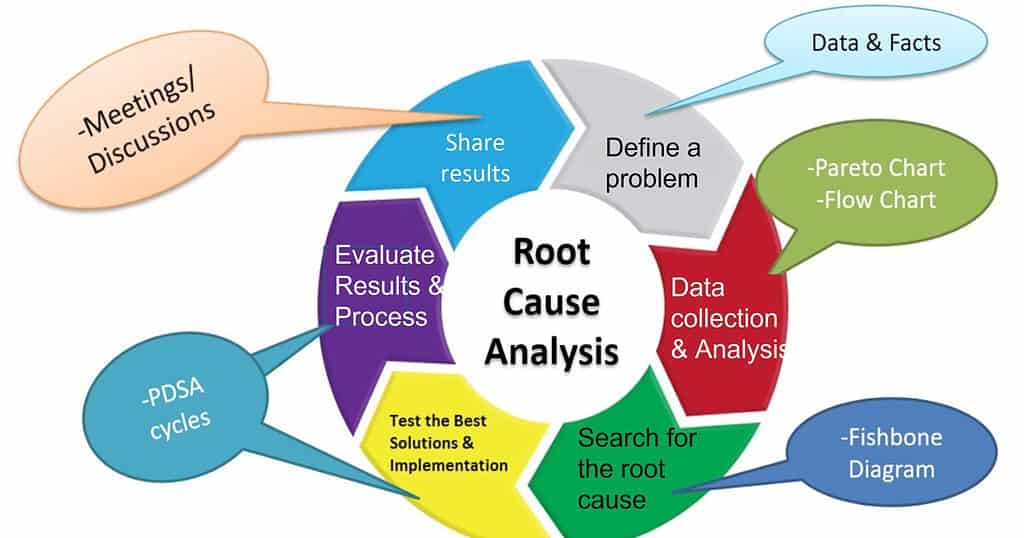
In the context of Six Sigma and Continuous Improvement, a root cause is defined as an issue or factor that causes a nonconformance or defect which, if eliminated, will improve the process. The root cause is the base issue which sets a cause-and-effect reaction in motion eventually resulting in a problem.
Overview: What is root cause analysis (RCA)?
The main problem with RCA is that it is reactive, not proactive. Before trying to do an RCA on your problem, you must first identify that you have a problem. This is different from employing a proactive approach using such tools as Failure Modes and Effects Analysis (FMEA) where you identify potential problems and address them before they occur.
The common steps used to conduct an RCA are:
- Select a team to conduct the root cause analysis.
- Team members are selected from the area that is experiencing the problem. Other team members might include:
- The process manager who implements any recommendations.
- An internal customer of the process exhibiting the problem.
- A Six Sigma expert such as Green Belt (GB), Black Belt (BB), or Master Black Belt (MBB) if specific improvement knowledge and tools are needed.
- During the RCA, emphasis is placed on defining and understanding the problem, brainstorming its possible causes, analyzing causes and effects, and recommending a solution to the problem.
- During the analysis time frame, the team should meet frequently.
- Depending on the complexity of the recommendations, the team may want to do a pilot first to see if the solution will work as intended.
- After implementation, the team should follow the progress to be sure the desired outcomes are happening and if not, be prepared to do some revisions.
The graphic below illustrates the process:

RCA can be accomplished by two distinct approaches. The first is through using statistical analysis and tools. The second can be done using more subjective analysis and tools. Statistical analysis strives to identify factors which are statistically shown to have an impact on process outcomes. Some of the statistical tools that can be used to try and find differences and relationships are:
- Hypothesis testing – Hypothesis testing is a statistical technique for making decisions about whether the problems in your process are a result of chance or a result of some specific factor. Some of the specific hypothesis tests might include:
- 1-sample t test
- 2-sample t test
- Analysis of Variance (ANOVA)
- Non-parametric tests
- Regression
- Simple linear regression
- Multiple regression
- Logistic regression
There are several RCA tools which are more subjective and intuitive in nature but are very useful in trying to identify possible root causes. Some of these are:
- A Fishbone diagram, also known as Ishikawa or Cause and Effect diagram, is used to identify various possible causes that led to the current problem.
- Five Whys is a technique that explores the hidden causes of the problem by repeatedly asking Why, approximately five times.
- A flowchart can be used to identify potential fail points in the process.
- A Pareto chart is usually performed to prioritize the possible causes of the problem in descending order of magnitude.
- A Scatter Plot is a graphical tool that illustrates whether there is a relationship between an input and output of a process.
3 benefits of RCA
RCA is the best way to try and identify what might be the underlying or root cause of your process problems. Here are a few of the benefits.
1. More definitive approach than guessing
RCA utilizes well known tools for identifying possible root causes. This is much more reliable than mere guessing or a seat of the pants approach.
2. Most tools are relatively simple to use
Most of the RCA statistical tools can be done with common statistical software or even Excel. Intuitive tools are also very easy to use and quite powerful.
3. If done properly will permanently eliminate the root cause of your problem
If you drill down deep enough and identify the true root cause, you will be able to eliminate or significantly reduce the impact of that root cause on your process.
Why is RCA important to understand?
While RCA is commonly used in many industries and processes, there are a few things that are important for you to understand.
Don’t discard the results of your RCA
If you have done your RCA correctly, then have faith in your results and don’t just ignore your findings because they don’t feel right.
The root cause may not be obvious
The purpose of RCA is to dig deep enough to find the true root cause. If you quit too early, you will only be treating another level of symptom rather than the true cause.
RCA is a team effort
No one person will ever have the only correct answer. Use a team approach and the synergy that comes from multiple people trying to find the root cause.
An industry example of RCA
The Plant Superintendent, Clint, was concerned with the amount of glass defects in the window manufacturing line. Clint pulled together a team from the line along with the plant engineer to address the cause of the increased defects.
The first step was to define the types of defects. The line supervisor had collected data, so the engineer helped the team develop the Pareto chart below.

As you can see, the number one type of defect was broken glass followed by scratches. The next step was to brainstorm the possible causes of the broken glass. The team then took those reasons and constructed a Fishbone diagram. From there they continued to ask the 5 Whys until they found the root cause. Clint made some changes in the process and the rate of broken glass was reduced by 74%.
3 best practices when thinking about RCA
Here are a few tips for effectively doing RCA.
1. Use a team approach
By utilizing process experts, process customers and suppliers, and improvement experts, you will maximize your ability to find the true root cause and improve your process.
2. Start with the easy tools
Start with some of the easy and intuitive tools such as brainstorming, fishbone diagram and 5 Whys. Then validate your suspicions with appropriate statistical tools.
3. Clearly define your problem
Be sure you clearly define your problem, and not just a symptom.
Frequently Asked Questions (FAQ) about RCA
What are some common root cause analysis tools?
Here are a few common RCA tools:
- The Ishikawa Fishbone Diagram
- Pareto Chart
- 5 Whys
- Scatter Diagram
- Affinity Diagram
- Fault Tree Analysis
What is the difference between FMEA and root cause analysis?
You need to have experienced a problem before you can analyze it for the root cause. FMEA or Failure Modes and Effects Analysis seeks to identify potential problems and then comes up with solutions to prevent or mitigate any problems from occurring.
Where does root cause analysis occur in the DMAIC methodology?
RCA will fall primarily in the Analyze (A) step of DMAIC. After collecting your data in the Measure (M) step, you now want to analyze your data for root cause.
Summary
Simply put, root cause analysis (RCA) is the process of searching for and identifying the root causes of problems to identify appropriate solutions to eliminate or mitigate any negative impact on your process. The graphic below summarizes the essence of RCA.
